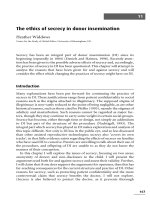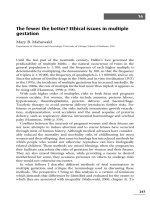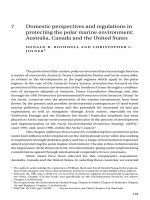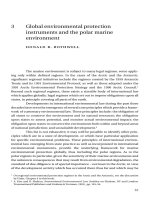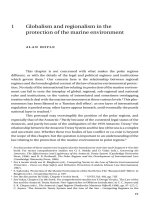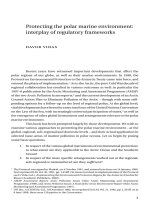The polar marine environment in regional cooperation
Bạn đang xem bản rút gọn của tài liệu. Xem và tải ngay bản đầy đủ của tài liệu tại đây (147.78 KB, 26 trang )
4 The polar marine environment in regional
cooperation
In the course of the 1990s, international cooperative efforts concerning
both the Arctic and the Antarctic have come to share one significant similarity: an
emphasis on international protection of the polar environment in general, and
the polar marine environment in particular. It maybe tempting to see this as a
natural consequence of the special features of polar regions, with
their environ-
ment characterised bydifficult ice conditions, including large areas of ice-
infested waters – and increased environmental risks which human activities
involve in this setting. This is what, broadlyspeaking, the opposite poles have in
common, and is also what sets them apart from all other parts of the globe.
1
However, this ‘first glance’ impression of a shared environmental focus due to
shared polar features maynot applywhen it comes to political realities and legal
measures. A closer look at current international instruments and institutional
arrangements for environmental protection of the two polar oceans, adopted
through the respective regional cooperation arrangements, reveals a somewhat
paradoxical situation.
As regards the Southern Ocean, recent assessments confirm that the
overall threat of pollution of its marine environment from sources within the
region appears generally low.
2
Nevertheless, the states parties to the 1959 Antarctic
Treaty
3
supplemented that treaty more recently with a comprehensive environ-
mental protection instrument: the Protocol on Environmental Protection to the
Antarctic Treaty.
4
In addition to providing a comprehensive regional environ-
mental protection regime for the Antarctic, the Protocol addressed protection of
Antarctic waters from vessel-source pollution at the regional level in a special
annex on ‘Prevention of Marine Pollution’.
As regards the opposite pole, the Arctic countries, since theystarted to
78
1
See the Introductory overview to this book.
2
See, for instance, COMNAP, ‘An Assessment of Environmental Emergencies Arising from Activities
in Antarctica’, doc. XXIII ATCM/WP 16, April 1999.
3
UNTS, Vol. 402, pp. 71ff.
4
The Protocol was adopted in 1991 and entered into force on 14 January 1998; text reprinted in ILM,
Vol. 30, 1991, pp. 1,461ff.
cooperate within the framework of the Arctic Environmental Protection Strategy
5
(AEPS), have identified the Arctic as being in need of a thorough examination of
its current status, including an inquiryinto international instruments for environ-
mental protection. Among the principal results of this intergovernmental cooper-
ative process have been several comprehensive assessments published between
1996 and 1998 – all confirming that both actual and potential sources of regional
pollution of the Arctic marine environment are far graver than those that may
threaten the Antarctic.
6
Despite this, no Arctic-specific multilateral instrument for
the protection of the marine environment has so far been adopted bythe Arctic
countries at the regional level. Indeed, Arctic policy-makers have not even con-
cluded that there is a need for such an
instrument. Their opinion has been
expressed in various documents that will be analysed in this chapter. Briefly
stated, theyhold that, for the time being, the existing global and other instruments
suffice, even though these are admittedlynot always tailored for polar Arctic
conditions.
For the marine environment of the Arctic – which appears more endan-
gered in environmental terms – policy-makers have failed to see the need for new
international legal regulations to strengthen protection at the regional level. By
contrast, those dealing with the Antarctic – where sources of pollution would seem
to pose far less threat to the environment – found it urgently necessary one decade
ago to adopt new legally binding rules at the regional level. Is then the need for
regional marine environmental protection in the Arctic underestimated? Or has
such a need in respect of the Antarctic marine environment been overestimated?
There is also a third possibility: perhaps the issue is neither solely, nor even pri-
marily, a matter of environmental needs, whether regional or not, but rather of
various other concerns. This chapter aims to look into these questions.
:
It is the differences between the Arctic and Antarctic regions, rather than
their similarities, that are traditionally pinpointed by most Arctic experts.
7
These
differences, it is often ar
gued, make each polar region a separate case, and little
would be gained by a comparative focus. Concerning protection of the marine
environment, one author has argued that comparison of the polar regions in this
respect can be misleading or inappropriate due to sharp contrasts between the
The polar marine environment in regional cooperation 79
5
Adopted at the First Ministerial Conference on the Protection of the Arctic Environment, at
Rovaniemi, Finland, 14 June 1991. Text reprinted in ILM, Vol. 30, 1991, pp. 1,624ff.
6
The two reports issued by the Arctic Monitoring and Assessment Programme (AMAP) should espe-
cially be noted: AMAP Assessment Report: Arctic Pollution Issues (Oslo: Arctic Monitoring and
Assessment Programme, 1998); and Arctic Pollution Issues: A State of the Arctic Environment Report
(Oslo: Arctic Monitoring and Assessment Programme, 1997).
7
See especially G. Osherenko and O. Young, The Age of the Arctic (Cambridge University Press, 1989),
pp. 242–4.
Arctic and Antarctic, especially since ‘no regional structure exists to facilitate or
promote cooperation’ among the Arctic states, while ‘evidence of agreement
among Arctic states on a legal structure for protecting the marine environment is
equally scanty’.
8
And, indeed, in the late 1980s, when this observation was made, it
was fully accurate.
Any international cooperation in Arctic environmental protection during
the 1980s was characterised by the conclusion of several bilateral agreements
between the Arctic countries – not by any regional instruments.
9
However, marine
environmental protection in the Arctic has predominantly been governed not by
bilateral agreements, but by unilateral acts promulgated by the Arctic rim states,
which acts are also partly based on Article 234 of the United Nations Convention
on the Law of the Sea
10
(LOS Convention). In contrast, during that same period, the
Antarctic Treaty Consultative Parties, working within the framework of the
Antarctic Treaty System (ATS), adopted at the regional level a series of multilateral
instruments related to the protection of the Antarctic environment, comprising
several international conventions,
11
as well as various other measures. The protec-
tion of the Antarctic environment has been approached through those instruments
in an issue-specific manner.
The years since the late 1980s have seen extraordinarily dynamic
developments in international cooperative efforts for the protection of the
environment in both polar regions. A regional cooperative structure among the
Arctic countries has emerged. Initiated in the late 1980s and adopted in the form of
the AEPS in 1991, Arctic regional cooperation has since 1996 been developing
within the framework of the Arctic Council.
12
In the Antarctic, changes of no less
importance have been underway since the late 1980s in regulating environmental
protection within the Antarctic Treaty System. Thus, the polar regions today seem
to share an important characteristic: the tendency to structure environmental pro-
tection through multilateral cooperation at the regional level.
Let us briefly review these simultaneous developments in the Antarctic
and Arctic regions, and then focus more closely on the current approaches taken
by these two regional cooperative processes for protecting the marine environ-
ment of their respective polar oceans from pollution.
80 Davor Vidas
18
A. E. Boyle, ‘Legal Regimes of the Arctic – Remarks’, American Society of International Law
Proceedings, Vol. 82, 1988, pp. 324 and 326.
19
For a concise overview see P. Kunig, ‘Arctic’, in R. Bernhardt (ed.), Encyclopedia of Public
International Law, Vol. 1 (Amsterdam: Elsevier Science, 1992), pp. 246–7.
10
Text reprinted in ILM, Vol. 30, 1982, pp. 1,261ff. On Art. 234 of the LOS Convention (‘Ice-covered
areas’) see the discussion byVukas, Chapter 2; Rothwell and Joyner, Chapter 7; and Brubaker,
Chapter 10 in this book.
11
In addition to the earlier adopted 1972 Convention for the Conservation of Antarctic Seals (CCAS;
reprinted in ILM, Vol. 11, 1972, pp. 251ff), the 1980s saw adoption of the 1980 Convention on the
Conservation of Antarctic Marine Living Resources (CCAMLR; reprinted in ILM, Vol. 19, 1980, pp.
837ff) and the 1988 Convention on the Regulation of Antarctic Mineral Resource Activities
(CRAMRA; reprinted in ILM, Vol. 27, 1988, pp. 868ff).
12
See the Declaration on the Establishment of the Arctic Council, signed by the eight Arctic states in
Ottawa, Canada, 19 September 1996; text reprinted in ILM, Vol. 35, 1996, pp. 1,387ff.
The Antarctic
The Antarctic Treaty System is what provides the mechanism for regional
cooperation in respect of the Antarctic.
13
Although the area of application of the
Antarctic Treaty lies within the confines of the Antarctic as a region, it is difficult to
regard the ATS as ‘regional’ cooperation stricto sensu, as this term is usually under-
stood in international law
14
– not least since the countries comprising the group of
twenty-seven Antarctic Treaty Consultative Parties belong to all the other six
(inhabited) continents, and various different regions. On the other hand, the ATS
is regionally applicable. Here the determining criterion for seeing that cooperation
as regional is the object of cooperation, not the geographical placement of the sub-
jects involved in cooperation.
This peculiar situation is the consequence of the fact that the entire
Antarctic TreatySystem, under continuous development for almost four decades
now,has been based on unresolvedsovereigntyissuesconcerningtheAntarctic.The
essential requirement in the development of the ATS was to build it, through coop-
eration, so as not to prejudice the position of anycountries claiming sovereigntyin
the Antarctic – or those not recognising these claims.
15
This international-level
governancesystem operatesthroughannualAntarcticTreatyConsultativeMeetings
as the main policy-making body regulating all human activities in the Antarctic.The
Antarctic TreatyConsultative Parties have decision-making capacityin this forum,
while other, non-Consultative Parties have the right to attend meetings.
16
There are
various other mechanisms for policy- and decision-making within the ATS, as well
as for scientific and technical advice;
17
and a definition of the ATS regarding its nor-
mative components has been formulated in the Environmental Protocol.
18
These
normative components todayinclude several international conventions noted
above and a large number of other measures that have been adopted.
The long-standing record of the issue-specific approach to Antarctic
environmental protection, introduced to the ATS through recommendations and
then through several international conventions, culminated in the adoption in
June 1988 of the Antarctic Minerals Convention, CRAMRA.
19
Shortly thereafter, the
The polar marine environment in regional cooperation 81
13
For a recent comprehensive study of the Antarctic Treaty System, see O. S. Stokke and D. Vidas
(eds.), Governing the Antarctic: The Effectiveness and Legitimacy of the Antarctic Treaty System
(Cambridge University Press, 1996).
14
On the understanding of ‘region’ and ‘regional cooperation’ in international law, see Boyle,
Chapter 1; and Vukas, Chapter 2 in this book.
15
See the interplay between various provisions of the Antarctic Treaty, especially Arts. IV and IX.
16
As of 8 June 1999, there were forty-four states parties to the Antarctic Treaty; twenty-seven are
Consultative Parties while the remaining seventeen are non-Consultative Parties.
17
For an overview of various components of the ATS, and of the various balances made among these,
see D. Vidas, ‘The Antarctic Treaty System in the International Community: An Overview’, in Stokke
and Vidas (eds.), Governing the Antarctic, pp. 35–60.
18
See Art. 1(e) of the Protocol.
19
For an overview, see C. C. Joyner, ‘The Effectiveness of CRAMRA’, in Stokke and Vidas (eds.),
Governing the Antarctic, pp. 152–62. See also F. Orrego Vicuña, Antarctic Mineral Exploitation: The
Emerging Legal Framework (Cambridge University Press, 1988); and R. Wolfrum, The Convention
on the Regulation of Antarctic Mineral Resource Activities: An Attempt to Break New Ground (Berlin:
Springer-Verlag, 1991).
‘CRAMRA crisis’ shook the ATS: in the course of the spring of 1989, Australia and
France announced that they would neither sign nor ratify CRAMRA, an attitude
that was soon adopted by several other Antarctic Treaty Consultative Parties.
20
Instead, these countries proposed a new instrument that would ban any mineral
activity (with the exception of scientific research) in the Antarctic, and would intro-
duce a comprehensive environmental protection system. Following a decision of
the 1989 Antarctic Treaty Consultative Meeting, a Special Meeting was convened
later the same year, in order to negotiate a new legal instrument. In a record time
of less than two years, this new legal instrument – the Protocol on Environmental
Protection to the Antarctic Treaty – was adopted in October 1991; though it then
took more than six years before eventually entering into force, in January 1998. One
of the Annexes to the Protocol is specifically devoted to protecting the Antarctic
marine environment from pollution from ships.
21
The great majorityof the provisions of the Protocol have been taken over
from recommendations adopted earlier. In fact, part of the Protocol’s basic
environmental principles come from CRAMRA – the veryinstrument which it
superseded.
22
While perhaps not bringing too much fresh regulation into the ATS,
the Protocol did approach the protection of the Antarctic environment in a com-
prehensive manner. It also ‘codified’ the existing recommendations into a legally
binding instrument. Moreover, it provided for the establishment of a new institu-
tion within the ATS, the Committee for Environmental Protection (CEP), operative
as of 1998. Thus, some have seen the Protocol as one of the most advanced interna-
tional legal instruments adopted to date in the field of environmental protection.
23
Since the Protocol
entered into force in 1998, the main preoccupation of
the Consultative Parties (which are all parties to the Protocol) became a complex
set of issues connected with implementation of this legal instrument.
24
In this
connection, the basic problem of the specific regional situation in the Antarctic is
the unresolved question of sovereigntyand jurisdiction, and thus – in the context
of this book – also of control and enforcement when it comes to implementation of
legal instruments for marine environmental protection in the Southern Ocean.
Other major issue-areas involved in the implementation of the Protocol include:
institutionalisation within the ATS; further normative development of the Protocol,
in particular the pending liabilityregime;
25
the relationship of the Protocol to other
82 Davor Vidas
20
See also Rothwell and Joyner, Chapter 7 in this book.
21
Annex IV of the Protocol; other annexes are also highly relevant for marine pollution, especially
Annex I (‘Environmental Impact Assessment’) and Annex III (‘Waste Disposal and Waste
Management’). See the discussion by Joyner, Chapter 5 in this book, which contains a detailed
examination of the Protocol and its annexes, as relating to protection against marine pollution in
the Antarctic.
22
See C. C. Joyner, ‘The Legitimacy of CRAMRA’, in Stokke and Vidas (eds.), Governing the Antarctic,
pp. 255–67.
23
See, for example, Joyner, Chapter 5 in this book.
24
For an examination of the various issues involved in the implementation of the Protocol, see D.
Vidas (ed.), Implementing the Environmental Protection Regime for the Antarctic (Dordrecht:
Kluwer Academic Publishers, 2000).
25
In Art. 16, the Protocol requires its parties to ‘elaborate rules and procedures relating to liability for
damage arising from activities taking place in the Antarctic Treaty area and covered by this
Protocol’.
applicable environmental agreements; and issues in domestic legislation adopted
in the implementation of the Protocol.
Thus, environmental protection of the Antarctic within the ATS is cur-
rently characterised by reliance on a regional multilateral instrument that is
already in force. Approaches to protection of the Antarctic environment tend to be
comprehensive and are adopted at the regional level, with the focus on a regional
cooperative structure which facilitates implementation. The protection of the
Antarctic marine environment lies within this general framework introduced by
the Protocol.
The Arctic
In the Arctic, the picture of cooperation is more complex and segmented,
in so far as environmental protection is addressed at various levels of cooperation
and regulation. Apart from the regional level, sub-regional cooperation is an
important and relatively recently added layer in environmental protection – for
example, within the Barents Euro–Arctic Region (BEAR).
26
Moreover, several other
forms of international environmental cooperation make up today’s Arctic cooper-
ative web, which also involves transnational, sub-national, non-governmental and
extra-regional cooperation.
27
Less than one decade ago, however, any international
cooperation between the Arctic countries was dominated by bilateral agree-
ments,
28
which of course still figure prominently in this area. Finally, domestic
legislation of Arctic coastal states has remained important in the overall regional
picture of marine environmental protection.
The focus on Arctic affairs has grown considerably since the late 1980s.
The dissolution of the Soviet Union and the easing of tensions between the two
Cold War rivals have presented new opportunities for the development of Arctic
cooperation – now on a multilateral, pan-Arctic regional level. The international
‘green wave’ offered an opportunity to divert and direct attention, including that of
the Arctic countries, to the environment. These major political changes, as well as
the growing awareness of the actual and potential threats to the Arctic environ-
ment, prompted a swift response from countries such as Finland: an initiative of
January 1989, aimed at the convening of a conference of the eight Arctic countries
on protection of the Arctic environment. For the purpose of this cooperative
process, the eight Arctic countries are defined as being Canada, Denmark/
Greenland, Finland, Iceland, Norway, Russia, Sweden and the United States.
The polar marine environment in regional cooperation 83
26
On sub-regional cooperation in the protection of the Arctic marine environment, see Stokke,
Chapter 6 in this book. For a comprehensive treatment of BEAR, see O. S. Stokke and O. Tunander
(eds.), The Barents Region: Cooperation in Arctic Europe (London: SAGE, 1994).
27
For a detailed overview, see Co-operation in the Arctic Region – Report Submitted to the Nordic
Council of Ministers (Copenhagen: Nordic Council of Ministers, 1995); see also D. Scrivener,
‘Environmental Cooperation in the Arctic: From Strategy to Council’, Security Policy Library, No. 1
(Oslo: Norwegian Atlantic Committee, 1996), pp. 3–33.
28
With the notable exception of the International Agreement on the Conservation of Polar Bears and
Their Habitats, done at Oslo, 15 November 1973, entered into force 26 May 1976; text reprinted in
ILM, Vol. 13, 1974, pp. 13ff.
Following several preparatory meetings, the first ministerial conference of the
Arctic countries addressing environmental protection was held in Rovaniemi,
Finland, in June 1991. It resulted in the adoption of the foundations for subsequent
Arctic environmental cooperation through the mid-1990s: the Declaration on the
Protection of the Arctic Environment (the Rovaniemi Declaration),
29
and the Arctic
Environmental Protection Strategy (AEPS), with its Action Plan.
Since 1991, this process has evolved through several programmes and
working groups which undertook data-gathering, compilation of information and
assessment tasks (sometimes also called
‘programmatic’ activities).
30
A major task
has been undertaken by the Arctic Monitoring and Assessment Programme, where
two main initial activities have been monitoring the Arctic environment, particu-
larly for contamination, and an assessment of the state of the Arctic environment.
A working group on the Protection of the Arctic Marine Environment (PAME) has
also been established, and its activities and results will be presented in further
detail below. Other components have included the Emergency P
revention,
Preparedness and Response Programme; the Conservation of Arctic Flora and
Fauna Programme; and the Task Force (later Working Group) on Sustainable
Development and Utilisation.
These AEPS components have reported to the ministers of the environ-
ment of the respective Arctic countries, who have reviewed their progress at inter-
vals of a few years. Following the 1991 Rovaniemi ministerial meeting, several more
ministerial conferences were held: in 1993 at Nuuk, Greenland; in 1996 at Inuvik,
Canada; and in 1997 at Alta, Norway. The latter was the final meeting of the AEPS
itself, whose existing programmes were thereupon integrated into the work of the
Arctic Council, which was established in 1996 as a ‘high level forum’.
31
During its
first two years the Arctic Council was chaired by Canada, and thereafter, until
October 2000, by the USA. The chairing functions and the hosting of ministerial
meetings of the Council rotate sequentially among the Arctic states on a biennial
basis;
32
and one Arctic Council ministerial meeting has been held so far, at Iqaluit,
Canada, in September 1998.
Building on the AEPS, the Arctic Council Declaration has taken a wider
view of the entire northern polar cooperation, with its two interconnected focal
points of sustainable development and environmental protection in the Arctic.
33
84 Davor Vidas
29
Adopted on 14 June 1991; text reprinted in ILM, Vol. 30, 1991, pp. 1,624ff.
30
See O. Young, ‘The Arctic Environmental Protection Strategy: Looking Backward, Looking
Forward’ (unpublished paper based on presentations at the Danish/American Greenland Science
Conference and the North Calotte Academy, April–May 1995; on file with author). See the elabora-
tion by Stokke, Chapter 6 in this book.
31
Para. 1 of the Arctic Council Declaration. On the Council’s takeover of the AEPS programmes, see
paras. 1(b) and 1(c) of the Arctic Council Declaration. See also para. 10 of the Alta Declaration on
the Arctic Environmental Protection Strategy, of 13 June 1997; text available at the Arctic Council
website at .
32
Paras. 4 and 5 of the Arctic Council Declaration.
33
See D. Scrivener, ‘Arctic Environmental Cooperation in Transition’, Polar Record, Vol. 35, 1999, pp.
51–8; and O. Young, ‘Sustainable Development in the Arctic: Operationalizing the Arctic Council’,
in L. Heininen and R. Langlais (eds.), Europe’s Northern Dimension: The BEAR Meets the South
(Rovaniemi: University of Lapland, 1997), pp. 259–77. See also D. Vidas (ed.), Arctic Development
and Environmental Challenges (Copenhagen: Scandinavian Seminar College, 1997).
This broader approach has been possible because of a strict separation from issues
of military security.
34
As to the protection of the Arctic marine environment, the 1991
Rovaniemi Declaration singled this out as a principal concern in the implementa-
tion of the AEPS. In the AEPS document itself, Chapter 4(2) addresses oil pollution;
this is, however, restricted to a listing of the principal international instruments
relevant to the Arctic, together with remarks on the need for further assessment of
their adequacy to Arctic conditions, as well as for stricter standards for oil transport
in the Arctic. Chapter 7 of the AEPS deals specifically with protection of the Arctic
marine environment. It emphasises the need for preventive measures, consistent
in particular with the LOS Convention, regarding marine pollution in the Arctic,
irrespective of origin.
At the 1993 Nuuk Conference, the ministers of the Arctic countries
agreed, in implementing Chapter 7 of the AEPS, to establish a working group to
assess:
the need for further action or instruments to prevent pollution of the Arctic
marine environment and to evaluate the need for action in appropriate inter-
national fora to obtain international recognition of the particularly sensitive
character of the ice-covered sea areas of the Arctic.
35
This, then, provided the terms of reference for the PAME working group. The scope
of its work was defined as the examination of the activities/sources of pollution and
their impact on the Arctic marine environment. On this basis the working group
was to evaluate possible options as to necessary legal instruments.
36
Accordingly,
in the period between the 1993 Nuuk and the 1996 Inuvik Ministerial Conferences,
PAME was particularly concerned with the choice of approach for protection of the
northern polar marine environment from pollution. Should the protection of the
Arctic marine environment be pursued by interpreting how relevant global marine
protection instruments may be applied to the Arctic case (and perhaps adapted in
some instances)? Or by creating a new regional regime specifically tailored to suit
the requirements of the protection of the Arctic marine environment? On the basis
of PAME’s main report on the matter,
37
the 1996 Inuvik Ministerial Conference con-
cluded:
taking into consideration the nature of the threats and an assessment of exist-
ing instruments, the existing instruments provide an adequate basis for the
The polar marine environment in regional cooperation 85
34
An explanatory note to para. 1(a) of the Arctic Council Declaration makes it clear that the Council
‘should not deal with matters related to military security’.
35
See para. 2 of the 1993 Nuuk Declaration on Environment and Development in the Arctic; the text
of the Declaration is available at the Arctic Council website at .
36
See para. 3(1)(a) in PAME, ‘Report from the First Meeting, Oslo, Norway, May 3–5, 1994’ (unpub-
lished document; on file with author). Following this, PAME held four more meetings before
finalising its main report and presenting it to the 1996 Inuvik Ministerial Conference.
37
Working Group on the Protection of the Arctic Marine Environment, Report to the Third
Ministerial Conference on the Protection of the Arctic Environment, 20–21 March 1996, Inuvik,
Canada (Oslo: Norwegian Ministry of the Environment, 1996) (PAME 1996 Report).
protection of the Arctic marine environment and there is no urgent need to
develop new legal instruments for this purpose.
38
In other words, the protection of the Arctic marine environment was to rely on
existing global and other instruments rather than any newly developed Arctic-
regional ones.
Nor has this overall situation changed under the Arctic Council. PAME
continued to work on several programmatic activities, in particular developing an
Arctic regional programme of action on land-based pollution,
39
guidelines for
offshore petroleum activities, as well as collecting information on current and
potential shipping activities in the Arctic – a course charted already at the Inuvik
Ministerial Conference.
Possibilities of mutual insight and communication
In considering recent inter-state processes in Arctic and Antarctic
environmental protection, we should note the significant degree of overlap of the
participating states: out of the eight countries directly involved in the AEPS and
Arctic Council processes, Iceland is the single country outside the Antarctic Treaty
System. The majority of Arctic countries (five out of eight) are also Consultative
Parties to the Antarctic Treaty: Norway, Russia/Soviet Union, and the United States
are original Consultative Parties, while Finland and Sweden acceded to the
Antarctic Treaty and subsequently acquired Consultative Party status. Canada and
Denmark are non-Consultative Parties to the Antarctic Treaty, though both have
relatively long-standing involvement in Antarctic cooperation.
40
Thus, all the Arctic
countries except Iceland were involved in the gradual creation of the regime for the
protection of the Antarctic environment, including its maritime space; and all of
these countries which are also Antarctic Treaty Consultative Parties are currently
bound by the Environmental Protocol applying there.
There seem to exist two main channels for communication between the
Arctic and Antarctic regional cooperative processes. One of these is at the practi-
cal, domestic decision-making level in those countries that are simultaneously a
party to the Antarctic Treaty and a member of the Arctic Council. In the foreign
ministries of Finland, Norway and Sweden, the same senior officials (‘polar ambas-
sadors’), or the same departmental units, are responsible for both Arctic and
Antarctic affairs.
41
Canada took a similar approach when in 1994 it appointed its
86 Davor Vidas
38
Para. 2(3) of the Report of the Third Ministerial Conference on the Protection of the Arctic
Environment, 20–21 March 1996, Inuvik, Canada (Ottawa: Canadian Ministry of Indian and
Northern Affairs, 1996).
39
See below in this chapter; and VanderZwaag, Chapter 8 in this book.
40
Denmark became party to the Antarctic Treaty in 1965, Canada in 1988.
41
However, that simultaneous coverage of affairs of both polar regions by the same senior official,
or the same departmental unit, seems more accentuated in the ministries of foreign affairs, and
less so in the ministries of the environment of these countries.
first polar ambassador, who was to focus especially on environmental issues and
to represent Canada at international meetings on circumpolar issues concerning
both the Arctic and the Antarctic.
42
To a certain extent, this is also true for the US
State Department, with the Polar Affairs Chief in the Bureau of Oceans and
International Environmental and Scientific Affairs.
43
The other channel for communication is at the international level of the
regional cooperative processes. As mentioned above, most Arctic countries are also
party to the Antarctic Treaty. In addition, several non-Arctic states, all Antarctic
Treaty Consultative Parties, take part in the Arctic Council as observers:
44
Germany,
the Netherlands, Poland and the United Kingdom. This overlap, and its inherent
potential for effective exchange between the two cooperative processes, has been
noted at the Antarctic Treaty Consultative Meetings, where some other countries
also cultivate a vigorous interest in Arctic developments. It was thus on a Chilean
initiative at the 1994 meeting that the Consultative Parties commenced consider-
ing the Arctic–Antarctic relev
ance ‘in matters of environmental protection’.
45
At the
1995 meeting, the Consultative Parties agreed that an exchange of main docu-
ments, adopted in the respective regional processes and containing information
on environmental issues, should go both ways, via the host country of the then
AEPS Ministerial Meeting.
46
This has since become a regular practice at the
Antarctic Treaty Consultative Meetings,
47
and has been adopted by the Arctic
Council as well.
In addition to a pure exchange of main documents and briefing on major
activities, this process of inter-polar communication has embodied two types of
policy emphasis. On the one hand, there is an emphasis on differences: a key
country in both polar contexts inter
vened at the 1996 Consultative Meeting, stress-
ing the differences rather than similarities between the Arctic and Antarctic. The
formulation which entered the final report from that meeting underlined:
the need to bear in mind that, as far as co-ordination was concerned, the polit-
ical and legal context governing activities in the Arctic and the Antarctic differ
considerably.
48
The polar marine environment in regional cooperation 87
42
See ‘Canada Names First Ambassador to Focus on Arctic Environmental Issues’, International
Environmental Reporter, Vol. 18, 1995, p. 52.
43
On the role of the US Polar Affairs Chief, see F. Griffiths, ‘Environment in the US Discourse on
Security: The Case of the Missing Arctic Waters’, in W. Østreng (ed.), National Security and
International Environmental Cooperation in the Arctic – The Case of the Northern Sea Route
(Dordrecht: Kluwer Academic Publishers, 1999), pp. 194–6.
44
This status is regulated under para. 3(a) of the Arctic Council Declaration.
45
See paras. 53 and 54 of the Final Report of the Eighteenth Antarctic Treaty Consultative Meeting,
Kyoto, Japan, 11–22 April 1994 (Tokyo: Ministry of Foreign Affairs of Japan, 1994).
46
See para. 35 of the Final Report of the Nineteenth Antarctic Treaty Consultative Meeting, Seoul, 8–19
May 1995 (Seoul: Ministry of Foreign Affairs of the Republic of Korea, 1995).
47
As of 1995, an agenda item titled ‘Relevance of developments in the Arctic to the Antarctic’
(renamed in 1996 to read ‘Relevance of developments in the Arctic and the Antarctic’) has figured
regularly on the agendas of all the Antarctic Treaty Consultative Meetings.
48
See para. 36 of the Final Report of the Twentieth Antarctic Treaty Consultative Meeting,Utrecht, The
Netherlands, 29 April–10 May 1996 (The Hague: Netherlands Ministry of Foreign Affairs, 1997).




